How to Have Effective Performance Conversations: A Comprehensive Guide for Managers
Table of contents

Performance conversations get a bad rap. Employees often fear negative feedback, and managers often don’t know how to have an effective performance conversation.
But it doesn’t need to be this way. Feedback can be a positive thing even when it’s constructive. So, let’s dive into why performance conversations matter and how to make them more productive.
What are performance conversations?
Performance conversations are meetings between managers and their direct reports where the manager gives constructive feedback on the employee’s performance, typically on an annual or biannual basis.
These discussions center around the employee’s past performance, goal tracking, progress analysis, and overall feedback. Performance review conversations are an important moment to check in on an employee’s overall impact and productivity in the organization. They are also a key opportunity to foster a stronger relationship between an employee and manager.
A performance review conversation can be intimidating. But when they take place within a broader culture of feedback where employees across the leadership spectrum are empowered to share both praise and constructive feedback with one another, they become much less daunting and feel more normalized.
Benefits of effective performance conversations
A performance review conversation should leave an employee feeling clear about their standing within the organization. That means they know what they’re doing well, where they need to improve, and what their next steps to achieve their goals are.
When done well, effective performance management and conversations can lead to:
- Improved employee engagement and motivation: Having clarity on your performance and goals is a surefire way to improve employee productivity.
- Enhanced team cohesion: When everyone takes part in the same performance review process, you get a more cohesive team.
- Better alignment with organizational goals: Your performance analysis should always ladder up to organizational goals. With everyone on the same page, the organization as a whole benefits.
- Strengthened organizational culture: An organization that isn’t afraid of feedback is a strong one. Empowering your employees with proper feedback training and enacting continuous performance management is a benefit to everyone across the gamut.
The latest Workhuman and Gallup research supports this and takes it one step further, indicating that frequency is a crucial element in how effective 1:1s are. The data shows that meeting at least weekly is a significant boost to the employee experience.
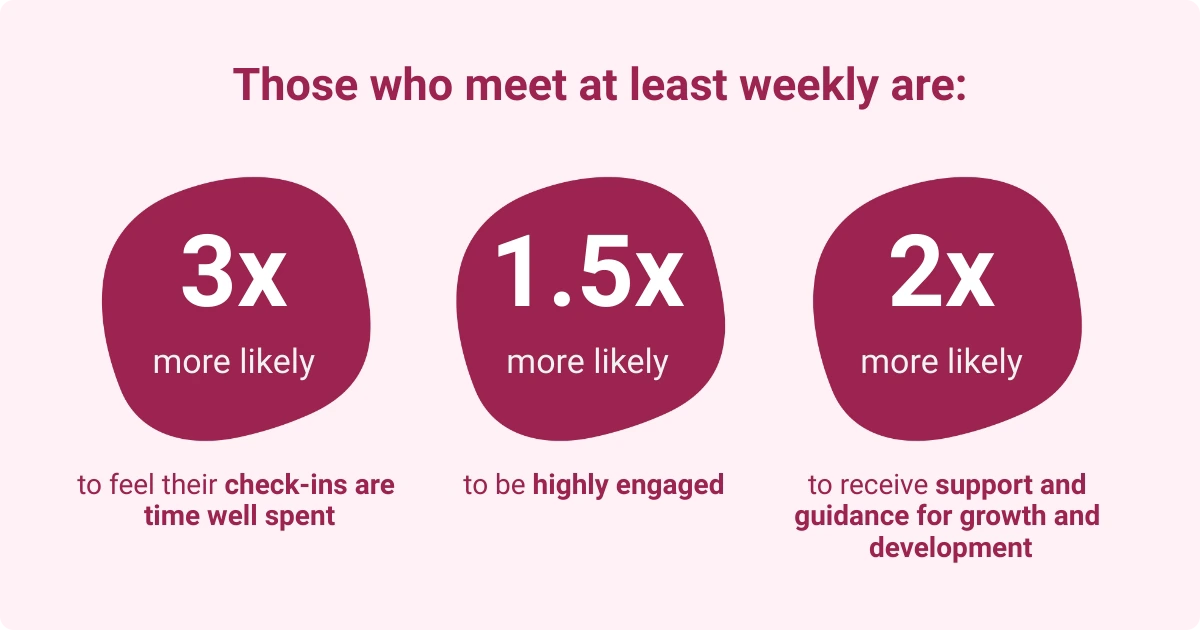
The employee-manager dynamics of productive performance conversations
Performance conversations have a negative connotation, but that’s only because they are often done so poorly. When done well, a performance conversation can give employees critical feedback that fuels their careers, builds development opportunities, and fosters strong relationships between employees and their managers.
Giving both positive and negative feedback is a natural part of the manager-employee dynamic. It’s important to view this not just as a step to check off for annual reviews but also as an opportunity to build trust and rapport with your direct reports.
As such, frame these conversations accordingly, both for yourself and for your direct reports. Let them know how you view performance management and how you approach it. Being transparent doesn’t just help foster understanding, but it also builds trust, which, again, is foundational to these kinds of meetings.
How to have productive performance conversations
Show up prepared
Employees can feel it when you show up without adequate preparation. Having an effective performance conversation is predicated upon being prepared. Ensure you take enough time before the meeting to gather all the data and feedback you need to give your employees productive performance feedback.
Employees can feel it when you’re unprepared or rushed. According to the same Gallup-Workhuman research, psychological safety decreases notably the more often a manager shows up rushed.
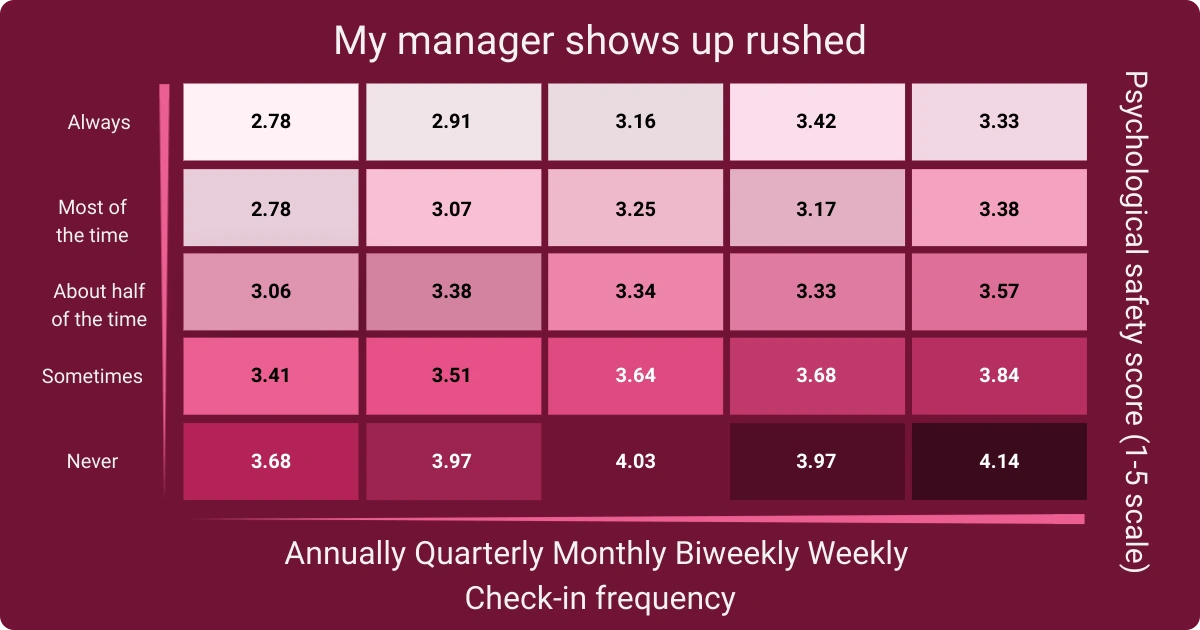
Set expectations
No one should go into performance review conversations unsure of what to expect. Review the meeting structure with your employees well before the conversation takes place so that they are more familiar. Being transparent about the process also helps cultivate a safe space, which is vital for these sometimes difficult conversations.
Be specific
When it comes to feedback, specificity is always the priority. Negative feedback lands more easily when it’s specific. “Your work quality isn’t adequate” is far less clear than “Your last quarterly analysis was missing key metrics, like ROI, which made the insights less actionable than expected.”
Avoid hyperboles like “you’re always late;” instead, say, “you’re often 5-10 minutes late to our weekly team meetings.” Following up with “Why?” also helps solicit the employee’s response and helps it become a more interactive conversation, which also contributes to a sense of safety.
Encourage employee participation
This is a two-way conversation. A one-sided stream of feedback can feel more like an attack and will make your team members feel like they can’t meaningfully participate. Asking about how or why certain projects or tasks happened the way they did enables the employee to share their perspective.
In these moments, you take on the role of an active listener and can ask follow-up questions to engage the conversation further. This self-reflection also indicates the employee’s own self-analysis, giving you an idea of how they view their own performance and professional development.
Follow up with a recap
Identify clear next steps following any performance conversation and share them with your employees to ensure alignment. This gives the employee a clear path to follow and gives you both something to which to stay accountable in the coming months. No matter how productive a conversation is, it’s all too easy to forget the details. Having a detailed document is a crucial reference.
Workhuman’s Conversations® makes having these meetings regularly – and following up on your discussion points – easy. Automated reminders keep you accountable to a productive meeting cadence while agile dashboards make it simple to keep track of what gets discussed and what needs to happen next.
Have regular feedback conversations
While all the tips in this blog are important and can help inform any individual performance conversation, the real key to effective performance management practices is ongoing feedback. Cultivating a culture of feedback makes feedback itself feel much more normalized and, thus, safer.
As you can tell from the research shared so far, if you only have one or two performance reviews or conversations per year – even if your annual review is as positive as it comes – the conversations you do have are going to feel much more tense than if you were adjusted to continuous feedback.
Employees who don’t have a consistent, effective check-in tend to feel disconnected and unsupported, with those who never meet 1:1 being more than 3x more likely to be highly disengaged.
Key elements of successful performance conversations
Frequency and timing
Workhuman found that checking in at least weekly is a top factor in increasing psychological safety – and that failing to do so decreases psychological safety.
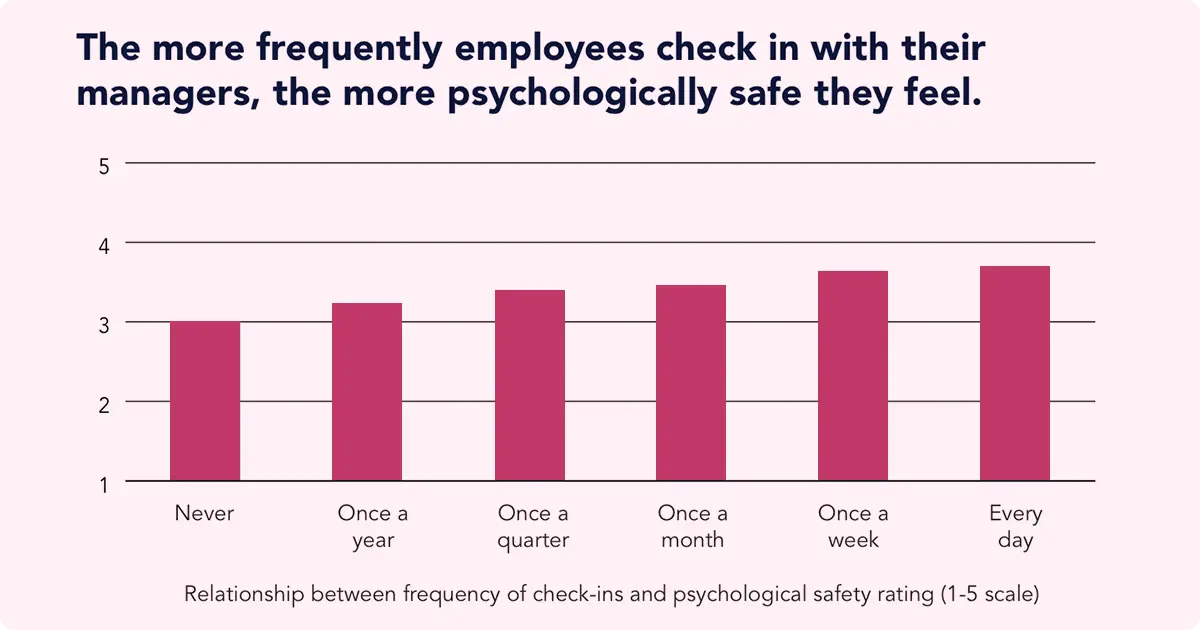
Regular, ongoing conversations, including feedback, make assessment and criticism feel more normal and less intimidating. It’s also a surefire way to improve the overall employee experience. When 1:1s are absent or nonexistent, employees suffer:
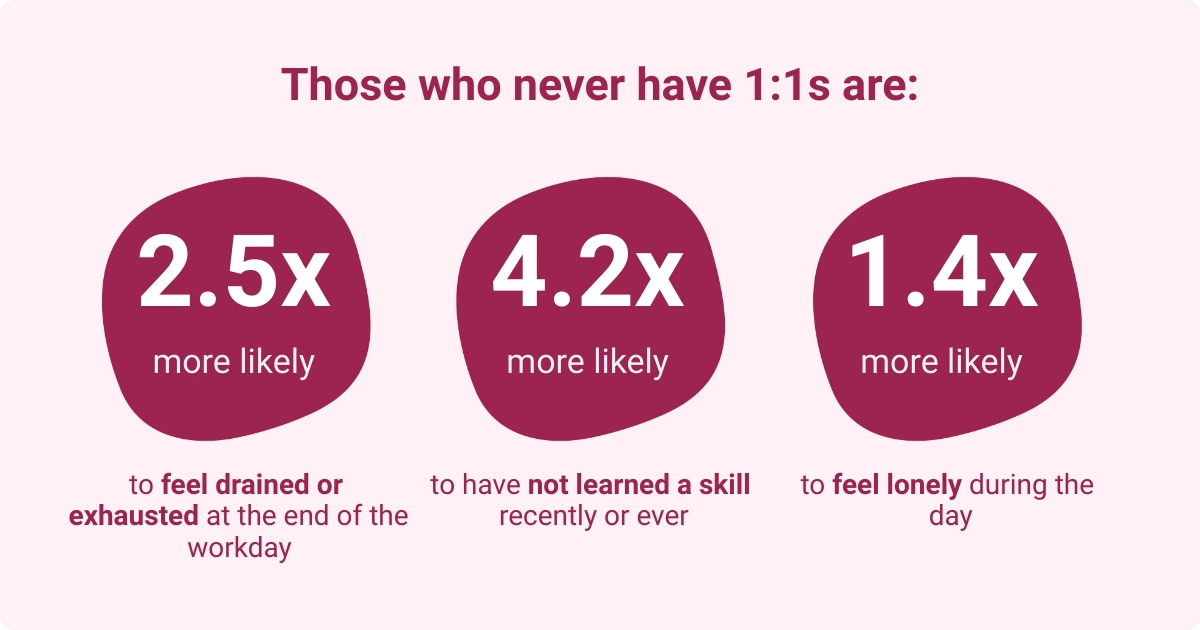
Consistency makes all feedback conversations easier. A positive performance management assessment will flow smoothly, while even a more difficult chat about poor performance is more likely to go well because both parties are seasoned feedback participants.
What does continuous feedback look like? A continuous performance management process involves a few different touchstones:
- Weekly one-on-one check-ins
- Quarterly goal-setting sessions
- Annual retrospective performance reviews
This blend of performance conversations empowers everyone to give and receive feedback at regular intervals, making them more skilled at giving detailed feedback as well as absorbing and acting on the feedback they receive.
Preparation
As mentioned, preparation is key to effective performance reviews. But how do you actually prepare?
Software like Workhuman’s Conversations® and Social Recognition® make it easy to review employee performance by keeping a detailed history of check-ins, achievements, goals, and recognition.
These tools aren’t just nice to have; they make a tangible impact on those who use them. Those who have and use a digital tool to support scheduled 1:1s, goals, and priority setting are 10x more likely to meet at least once per week than those who don’t.
You can review your check-ins with each team member to see what themes and key points have been present over the previous time period. You can also look through what recognition they have received to assess specific actions and achievements.
Workhuman’s latest innovation, Workhuman iQ, and the AI Assistant take this analysis a step further. You can ask the AI Assistant specific questions to go deeper and get vital insights faster. This empowers you to provide feedback that is both data-driven and human – true Human Intelligence.
Addressing performance issues
Of course, performance review conversations present the opportunity for both positive and negative feedback. Critical feedback can be daunting, but it can be done in a productive way that leaves the employee feeling empowered to make positive changes in their career.
Identifying performance gaps
The best (and most objective) way to identify performance gaps is through skills analysis. It’s vital to have a tool that can map your team members’ skills so you can see where they’re excelling and where they might need upskilling.
Workhuman iQ’s Skills dashboard pulls from recognition data to show what skills employees are recognized for and track how their skills evolve over time.
Constructive feedback techniques
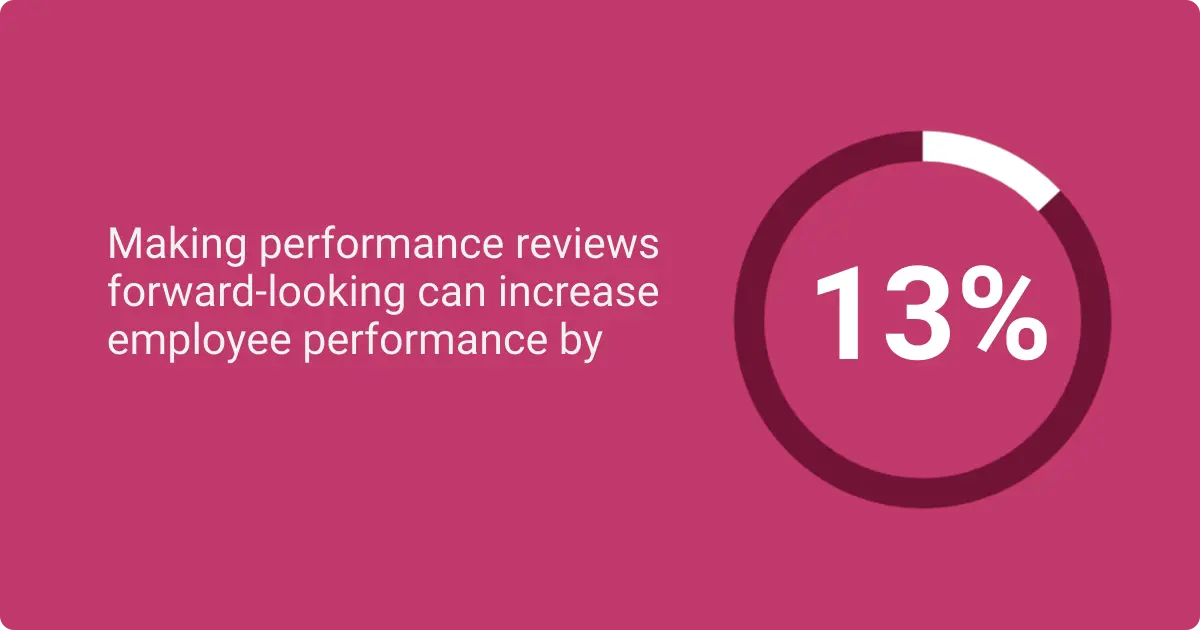
Constructive feedback must be rooted in future-facing improvement, not past shortcomings. Focusing on the future gives the employees hope, which helps keep them engaged and motivated. Gartner's research onOpens in a new tab performance management conversations found that making performance reviews forward-looking can increase employee performance by 13%.
Use the Situation Behavior Impact (SBI) model to provide constructive feedback:
- Situation: Describe the specific situation or context upon which you need to provide feedback. Be as detailed as possible.
- Behavior: Share your observations of the employee’s behavior in this context. Keep it factual and objective. No judgment or assumptions.
- Impact: Take all of the above to explain the impact the situation had on you as a manager, your direct report, or the broader team or organization. This puts the situation into greater context to understand the consequences of the behavior.
This model takes the focus off the individual and places it on the behavior exhibited by said individual. It can make critical feedback feel less personal and enable the recipient to understand what specific behaviors to improve.
Conclusion
Feedback doesn’t need to have a negative connotation. When wielded properly, it can be a gift to everyone involved. It can empower employees to make meaningful changes in their careers and drive an organization to be more honest and cohesive as a whole. Productive, effective performance conversations are possible – you just have to put your best foot forward.
About the author
Maeve Ginsberg
A wellness enthusiast and the mid-day walk’s #1 fan, Maeve champions work-life balance.
Having gone from a corporate job to self employment, Maeve has lived through countless working styles. This evolution forced confrontation of her own limiting beliefs, eventually breeding a completely individualized approach to work and productivity.
As a Senior Copywriter, Maeve often writes on workplace wellbeing and strives to advocate for all workers and leaders to find small yet significant ways to make their work lives healthier and more fulfilling.
Offline, Maeve enjoys testing new cuisines and hanging upside down off walls (also known as bouldering).